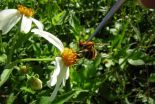(Press-News.org) Scientists already knew that some social bee species warn their conspecifics when detecting the presence of a predator near their hive, which in turn causes an attack response to the possible predator. Researchers at the University of Tours (France) in collaboration with the Experimental Station of Arid Zones of Almeria (Spain) have now demonstrated that they also use chemical signals to mark those flowers where they have previously been attacked.
Researchers at the University of Tours (France) and the Experimental Station of Arid Zones of Almeria (EEZA-CSIC) conducted an experiment to study whether bees are capable of using evasive chemical signals to mark those flowers where they have previously been attacked. For this purpose, they simulated a predator attack and observed whether the bees advised the rest of their conspecifics of the danger of gathering nectar at a certain plant.
"Evasive alarm pheromones provoke an escape response in insects that visit a particular flower and until now, we were not sure of the role that these pheromones played in social bees. Our results indicate that, unlike solitary bees, social bees use this type of alert system on flowers to warn their conspecifics of the presence of a nearby predator," as explained to SINC by Ana L. Llandres from the University of Tours and lead author of the study published in the 'Animal Behaviour' journal.
In order to determine whether social and solitary bees responded to these olfactory alarm signals, an experiment was performed using individuals from both types and from different countries: Australia, China, Spain and Singapore.
In some plants the predator attack was simulated by trapping the bees with pincers whereas in other cases control plants were used in which no attack took place.
"Solitary bees responded similarly in the case of flowers that had been attacked by control predators and control flowers. However, social bees responded very differently," explains L. Llandres. "Despite approaching both types of flower, the probability of landing on control flowers was much higher." The scientists also detected that the probability of social bees rejecting flowers was much greater if a predator attack had been previously simulated.
This study supports the idea that the sociability of bees is linked to the evolution of warning signals.
INFORMATION:
References:
Ana L. Llandres, Francisco G. Gonzálvez, Miguel A. Rodríguez-Gironés. "Social but not solitary bees reject dangerous flowers where a conspecific has recently been attacked", Animal Behaviour 85: 97- 102, 2013.
Social bees mark dangerous flowers with chemical signals
2013-03-14
ELSE PRESS RELEASES FROM THIS DATE:
23andMe identifies multiple genetic factors impacting development of nearsightedness
2013-03-14
Mountain View, Calif. – March 14, 2013 – In the largest ever genome-wide association study on myopia, 23andMe, the leading personal genetics company, identified 20 new genetic associations for myopia, or nearsightedness. The company also replicated two known associations in the study, which was specific to individuals of European ancestry. The study included an analysis of genetic data and survey responses from more than 50,000 23andMe customers and demonstrates that the genetic basis of myopia is complex and affected by multiple genes.
Myopia is the most common eye ...
New early warning system for the brain development of babies published in video journal
2013-03-14
A new research technique, pioneered by Dr. Maria Angela Franceschini, will be published in JoVE (Journal of Visualized Experiments) on March 14th. Researchers at Massachusetts General Hospital and Harvard Medical School have developed a non-invasive optical measurement system to monitor neonatal brain activity via cerebral metabolism and blood flow.
Of the nearly four million children born in the United States each year, 12% are born preterm, 8% are born with low birth weight, and 1-2% of infants are at risk for death associated with respiratory distress. The result ...
CITES makes historic decision to protect sharks and rays
2013-03-14
Bangkok, 14 March 2013. CITES plenary today accepted Committee recommendations to list five species of highly traded sharks under the CITES Appendices, along with those for the listing of both manta rays and one species of sawfish. Japan, backed by Gambia and India, unsuccessfully challenged the Committee decision to list the oceanic whitetip shark, while Grenada and China failed in an attempt to reopen debate on listing three hammerhead species. Colombia, Senegal, Mexico and others took the floor to defend Committee decisions to list sharks.
"We are thrilled with this ...
Statement by WCS president and CEO on historic CITES ruling
2013-03-14
BANGKOK -- March 14, 2013 -- The following statement was issued today by WCS President and CEO Cristian Samper:
The Wildlife Conservation Society (WCS) today celebrates the decision by an historic, broad group of nations from around the world to list five new sharks, freshwater sawfish, and two manta ray species for protection by the Convention on International Trade in Endangered Species of Wild Fauna and Flora (CITES). This vote is a first, critical step in working to ensure that international trade does not threaten the survival of commercially valuable shark and ray ...
Discards ban could impact seabird populations
2013-03-14
The European Parliament recently voted to scrap the controversial discards policy, which has seen fishermen throwing thousands of edible fish and fish waste back into the sea because they have exceeded their quotas.
Scientists at Plymouth University believe this could have a negative impact on some seabirds, which have become used to following the fishing vessels and are increasingly reliant on their discards.
But they say others could return to using foraging as their sole source of food, as long as there are sufficient numbers of fish to meet their needs.
Dr Stephen ...
Chemical chameleon tamed
2013-03-14
How you get the chameleon of the molecules to settle on a particular "look" has been discovered by RUB chemists led by Professor Dominik Marx. The molecule CH5+ is normally not to be described by a single rigid structure, but is dynamically flexible. By means of computer simulations, the team from the Centre for Theoretical Chemistry showed that CH5+ takes on a particular structure once you attach hydrogen molecules. "In this way, we have taken an important step towards understanding experimental vibrational spectra in the future", says Dominik Marx. The researchers report ...
New research discovers the emergence of Twitter 'tribes'
2013-03-14
A project led by scientists from Royal Holloway University in collaboration with Princeton University, has found evidence of how people form into tribe-like communities on social network sites such as Twitter.
In a paper published in EPJ Data Science, they found that these communities have a common character, occupation or interest and have developed their own distinctive languages.
"This means that by looking at the language someone uses, it is possible to predict which community he or she is likely to belong to, with up to 80% accuracy," said Dr John Bryden from ...
What do American bullfrogs eat when they're away from home? Practically everything!
2013-03-14
American bullfrogs are native to eastern North America but have been transported by people to many other parts of the globe, and other parts of North America, where they have readily established populations and become an invasive alien menace to native ecosystems. In the largest study of its kind to date, the stomach contents of over 5,000 invasive alien American bullfrogs from 60 lakes and ponds on southern Vancouver Island were examined to identify the native and exotic animals that they had preyed upon. The study was published in the open access journal NeoBiota.
Over ...
The mysterious GRIN3A and the cause of schizophrenia
2013-03-14
Philadelphia, PA, March 14, 2013 – Since the 1960s, psychiatrists have been hunting for substances made by the body that might accumulate in abnormally high levels to produce the symptoms associated with schizophrenia. In particular, there was a search for chemicals that might be related to the hallucinogens phencyclidine (PCP) or lysergic acid diethylamide (LSD), which could explain the emergence of psychotic symptoms in schizophrenia. This "auto-intoxication" hypothesis led investigators on a wild goose chase where substances, including the "Pink Spot" and the "Frohman ...
Testing can improve learning among young and old people
2013-03-14
Testing can improve learning among young and old people alike, according to new research from Rice University.
The study found that regardless of their age, intelligence or whether they work or attend college, people appear to learn more by taking tests rather than merely rereading or studying information. The research was published in the March 2013 edition of Psychology and Aging.
"There is a significant body of research examining the benefits of testing among young students," said Ashley Meyer '09, the study's lead author. Currently a cognitivepsychologist with the ...


